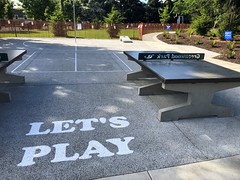It is impossible to pinpoint exactly when the story began. The sequence of events leading up to the installation of public ping-pong tables at Seattle's Cal Anderson Park is nothing less than the history of the human race, a story woven with an unbroken thread of oppression. As long as there has been power, it has been abused by those who have it in an effort to maintain it. The United States certainly did not invent oppression, but it was in many ways built upon it. From the slaughter of Native Americans and theft of their land, to the industrialized brutality of slavery, to the lingering effects of systemic racism, oppression is embedded it in the fabric of our nation. On May 25, 2020, an unarmed black man named George Floyd was killed by police in Minneapolis, Minnesota. Floyd's death, coming on the heels of so many tragically similar stories, ignited protests across the nation and around the world. In Seattle's Capitol Hill, protesters allied with the Black Lives Matter movement occupied several residential blocks and Cal Anderson Park. Initially dubbed the Capitol Hill Autonomous Zone (CHAZ), the protesters were eventually re-christened the Capitol Hill Organized Protest, or CHOP. Over a contentious, occasionally violent summer, a tense stand-off between protesters and law enforcement became fodder for politicians and pundits, who preferred blustery tirades to any form of constructive dialogue. The regrettable effect of this rhetoric is the pervasive misconception that supporting Black Lives Matter is an anti-police action. We all rely on police protection, and should be grateful for their brave service. We should not allow the violent and illegal actions of some police tarnish the venerable institution of law enforcement, any more than we should allow the violent and illegal actions of some protesters to distract from their desperate cries for social justice. Black Lives Matter and Blue Lives Matter are not mutually exclusive ideas, but this false dichotomy has quickly taken root and run rampant in the divided ground of our nation. The protesters, meanwhile, broke ground on a community garden and began to develop an infrastructure for the city's homeless population. Eventually, community safety concerns and the worsening COVID-19 pandemic forced the city to close the park, leaving the homeless once again homeless. Over the ensuing six months, Seattle Parks and Recreation (SPR) removed 100 tons of debris from the park, part of an "intensive maintenance and cleaning" campaign. Today, the park officially reopened. In an effort to lure more recreational foot traffic, SPR installed several outdoor ping-pong tables. Equipment is available from park officials during normal business hours. "Cal Anderson Park has been an epicenter for activism and social justice movements for decades and is the heart of the Capitol Hill community," says Seattle mayor Jenny Durkan. "As we reopen the park, the community and the City will continue its ongoing conversation to provide services to those who are unhoused, create new ongoing activities to support diverse community needs, increase safety, and restore the vibrancy and inclusivity of the Capitol Hill neighborhood." Cal Anderson Park itself is a tribute to pioneers in the ongoing struggle for equality, named for the first openly gay state legislator in Washington state history. Although no one can say when the story of oppression began, we persist in the hope that we can see how it ends.
More at The Seattle Times
